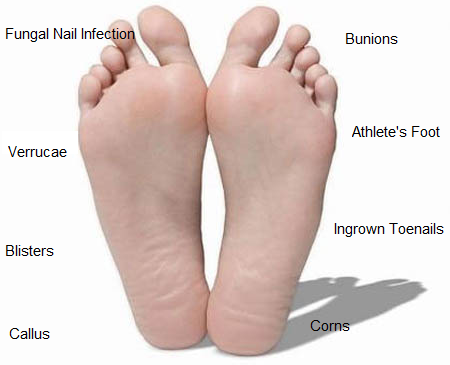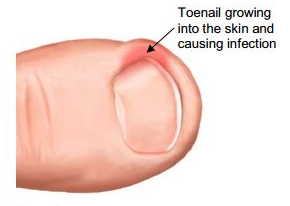 Foot complaints are common and can affect anyone from Olympian athletes to those who don’t participate in sporting activities at all.
Foot complaints are common and can affect anyone from Olympian athletes to those who don’t participate in sporting activities at all.
Simple things such as poorly fitting footwear can result in a foot problem and our Podiatrists here at Newcastle Sports Injury Clinic are well versed in the treatment of many forms of foot complaints.
Here we explain some of the most common foot problems and give an indication on what treatments are available to you should you find you are suffering from one of these conditions.
Verruca – Otherwise known as a plantar wart, the verruca is a viral infection of the skin found in the sole of the foot. These can be very painful and are notoriously difficult to treat. Podiatrists can treat verrucae using salicylic acid (40-70%) or using a technique called needling; both treatments encourage the body’s immune response to kill the verruca. It is advised that people do not use over-the-counter remedies as these can in fact cause the virus to spread, or the treatments can damage surrounding healthy tissue.
Athlete’s Foot – This is a fungal infection which can cause the skin to become very itchy, red, and broken. People with sweaty feet are more likely to suffer with this condition as the moisture encourages the fungus to replicate and grow. Effective anti-fungal medication in the form of creams and sprays can be purchased from a Pharmacy. It is advised that as well as medication, sufferers should also change their socks daily, avoid sharing towels and wash feet with soap, paying attention to drying between the toes.
Fungal nail infection – Often the same fungus that causes Athlete’s Foot can affect the skin in the nail bed, which causes the nail to become crumbly and yellow. This is particularly common if the nail is damaged as it provides a portal of entry for the fungus to take hold. For a diagnosis to be made, clippings of the affected nail will be taken and sent for a microbiology analysis. Fungal nails can be effectively treated using oral medication or nail lacquer. Other options such as nail surgery can be discussed with your podiatrist.
Corns and callus – These are areas of hard skin which build up under pressure points. Forces such as friction, compression, or tension act to encourage skin growth in the pressure area at a rate faster than the outer layer of skin (stratum corneum) can shed. Podiatrists effectively treat corns and callus by removing the outer layer of skin. Regular moisturisation of the feet can also help soften the pressure areas and improve the tissue integrity of the skin. Try to avoid over-the-counter treatments as often the active ingredients can damage healthy tissue leading to further problems, such as chronic wounds.
Bunions – This is a joint deformity that affects the hallux (big toe) where the first metatarsal (long bone) meets the proximal phalange (bone in the hallux) which forces the hallux to deviate towards the second toe. A fluid filled sac is created in the process to protect the head of the metatarsal; this can be painful when rubbing against footwear.
Often genetics plays a large factor in the formation of bunions, however there are actions you can take for prevention. Narrow or ill-fitting footwear, or shoes that are too high can make the problem worse, therefore if possible, invest in a pair of trainers which have a toe-box deep and wide enough to accommodate the bunion. If you work in steel-toe cap shoes as part of your job and are finding them too narrow for your deformity, try asking your employer for wider fitting shoes.
A podiatrist can provide you with orthotics if your foot is mobile enough to respond, however treatment tends to involve surgery if the deformity is at a stage where it prevents walking through the normal gait process.
Blisters – Blisters are painful, fluid-filled lesions produced by friction and pressure. They can be caused by ill-fitting or stiff shoes, wrinkled socks against the skin or foot deformities. To prevent blisters, try to keep your feet dry, wear properly fitting shoes, and always wear socks as a cushion between your feet and shoes. If you do develop a blister cut a hole in a 1.5” piece of foam or felt, forming a ‘doughnut’ over the blister; tape the foam or felt in place or cover with a soft gel-type dressing. Treat an open blister with mild soap and water; cover it with an antiseptic ointment and protective soft gel dressing to prevent infection and speed up the healing process.
 Ingrown Toenail – Incorrect nail cutting, trauma or ill-fitting footwear can cause the nail to break and grow into the skin causing pain, swelling and in severe cases, infection. Often the most effective treatment for this is nail surgery to remove or partially remove the nail. Conservative care by your podiatrist is also an option but it can be difficult to resolve the problem completely without surgical intervention. Antibiotics may need to be used alongside podiatric care. To prevent ingrown toenails cut straight across and not down the sides.
Ingrown Toenail – Incorrect nail cutting, trauma or ill-fitting footwear can cause the nail to break and grow into the skin causing pain, swelling and in severe cases, infection. Often the most effective treatment for this is nail surgery to remove or partially remove the nail. Conservative care by your podiatrist is also an option but it can be difficult to resolve the problem completely without surgical intervention. Antibiotics may need to be used alongside podiatric care. To prevent ingrown toenails cut straight across and not down the sides.
There are simple steps you can take to prevent the occurrence of these conditions, however, if you are concerned that you may have one of these foot problems please contact the clinic on 0191 2330500 and one of our therapists can provide you with some advice and where necessary arrange an appointment for treatment.

